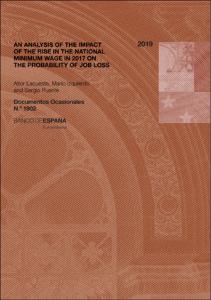Registro completo de metadatos
| Campo DC | Valor |
|---|---|
| dc.contributor.author | Lacuesta, Aitor |
| dc.contributor.author | Izquierdo, Mario |
| dc.contributor.author | Puente, Sergio |
| dc.coverage.spatial | España |
| dc.date.accessioned | 2019-08-14T07:34:38Z |
| dc.date.available | 2019-08-14T07:34:38Z |
| dc.date.issued | 2019-02-01 |
| dc.identifier.issn | ISSN: 1696-2230 (en línea) |
| dc.identifier.uri | https://repositorio.bde.es/handle/123456789/8801 |
| dc.description.abstract | En este artículo se analiza la subida del salario mínimo interprofesional (SMI) en 2017 en España, a partir de la información proporcionada por la Muestra Continua de Vidas Laborales. Los resultados indican que dicha subida habría tenido un efecto negativo sobre la probabilidad de mantener el empleo entre el colectivo de trabajadores con salarios por debajo del nuevo salario mínimo, que sería especialmente importante para los trabajadores de más edad. La subida aprobada para el SMI en 2019 es muy superior a las observadas en el pasado, lo que eleva considerablemente el número de trabajadores afectados y la incertidumbre en torno a los efectos negativos sobre la probabilidad de mantener su empleo. De acuerdo con las estimaciones presentadas en este artículo, estos efectos negativos podrían ser significativos |
| dc.description.abstract | This article analyses the rise in the national minimum wage (NMW) in 2017 in Spain, drawing on information provided by the Social Security administrative labour records (MCVL). The results suggest this rise may have had an adverse effect on the probability of the group of workers with wages below the new minimum wage keeping their jobs. This effect would be of particular importance for older workers. The rise approved for the NMW in 2019 is far higher than those observed in the past, which considerably increases the number of workers affected and the uncertainty surrounding the adverse effects on the probability of them keeping their jobs. According to the estimates presented in this article, these negative effects could be significant |
| dc.format.extent | 21 p. |
| dc.language.iso | en |
| dc.publisher | Banco de España |
| dc.relation.ispartof | Documentos Ocasionales / Banco de España, 1902 |
| dc.relation.hasversion | Versión en español 123456789/8780 |
| dc.rights | Reconocimiento-NoComercial-CompartirIgual 4.0 Internacional (CC BY-NC-SA 4.0) |
| dc.rights | In Copyright - Non Commercial Use Permitted |
| dc.rights.uri | https://creativecommons.org/licenses/by-nc-sa/4.0/deed.es_ES |
| dc.rights.uri | http://rightsstatements.org/vocab/InC-NC/1.0/ |
| dc.subject | Salario mínimo |
| dc.subject | Empleo |
| dc.subject | Transiciones empleo-desempleo |
| dc.subject | Minimum wage |
| dc.subject | Employment |
| dc.subject | Employment-to-unemployment flows |
| dc.title | An analysis of the impact of the rise in the national minimum wage in 2017 on the probability of job loss |
| dc.type | Documento de trabajo |
| dc.identifier.bdebib | 000464855 |
| dc.identifier.bdepub | DOCA-201902-eng |
| dc.subject.bde | Mercado de trabajo |
| dc.publisher.bde | Madrid : Banco de España, 2019 |
| dc.subject.jel | J23 |
| dc.subject.jel | J30 |
| dc.subject.jel | J38 |












